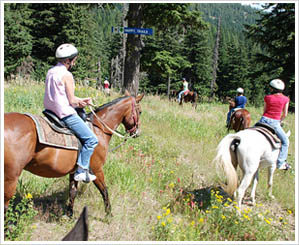Exploring the Pyrenees on horseback
 Saint-Jean-Pied-de-Port, France - Time was when only farmers and smugglers knew the trails through the Pyrenees. The mountains along the border between France and Spain are still largely deserted today. There are lots of sheep, cows and horses, though, all wandering around freely.
Saint-Jean-Pied-de-Port, France - Time was when only farmers and smugglers knew the trails through the Pyrenees. The mountains along the border between France and Spain are still largely deserted today. There are lots of sheep, cows and horses, though, all wandering around freely.
Horseback riders suit this scenery well, and hikes on horseback are a great way to explore the region.
A heavy thunderstorm had soaked the mountainsides overnight, and it was still drizzling in the morning. Wrapped in rain ponchos, our group saddled the horses. Their hooves clattered on the cobblestones of Saint-Jean-Pied-de-Port, at the foot of the western Pyrenees.
The medieval town is the traditional starting point for the last French stage of the Camino de Santiago, a collection of old pilgrimage routes known in English as The Way of St James. The route from here passes through the mountains into Spain.
The ascent was hard work for the horses. In the distance, tiny white dots stood out against the green meadows. We came closer, and they turned out to be sheep. The shepherd was nearby. As if to satisfy the stereotype, he was wearing a beret and carrying a wooden staff.
Lunch was on the Col de Munhoa, a peak 1,021 metres above sea level. We had brebis cheese from raw sheep's milk, black cherry jam and Basque cake.
It did not take long before we had internalized the daily rhythm of our weeklong mountain tour on horseback: mounting the animals in the morning followed by an up-and-down ride of five, six or sometimes eight hours. Viewing the scenery quickly became a kind of meditation in the saddle.
One day we rode along the border between France and Spain, which is marked by barbed wire. The border is green and covered with ferns, mauve-flowering heather, and bellflowers. Not a soul to be seen far and wide. "Smugglers once transported alcohol here," noted our guide Sarah Dubreuil. Today's drug traffickers have other routes.
The horses and riders spent each night in a village along the way. Espila, Urepel, Saint-Etienne-de-Baigorry, Ainhoa - in all of these places, half-timbered houses with red and green beams and shutters caught the eye.
The pride of every village is the court for pelota, a traditional sport played with a small, hard ball. In one village that we rode into, a school class was noisily practicing. Their leather ball flew back and forth fast, but the horses stayed calm.
They never got skittish, in fact - except on the following day, when two boars blocked the trail. It was too narrow to pass by so we had to drive the boars before us.
Then we reached a ridge. The wind tousled the horses' manes. On both sides of the ridge, the Pyrenees literally lay at our feet. The trail led westward, and our goal, the Atlantic Ocean, glittered in the distance.
On the next ridge we saw a herd of horses. Curious, they quickly surrounded us. "It's an old Basque horse breed," our guide explained. "These small, robust horses are closely related to primeval horses."
Just as they were wont to do in ancient times, the semi-wild ponies graze in a mountain landscape without fences. (dpa)